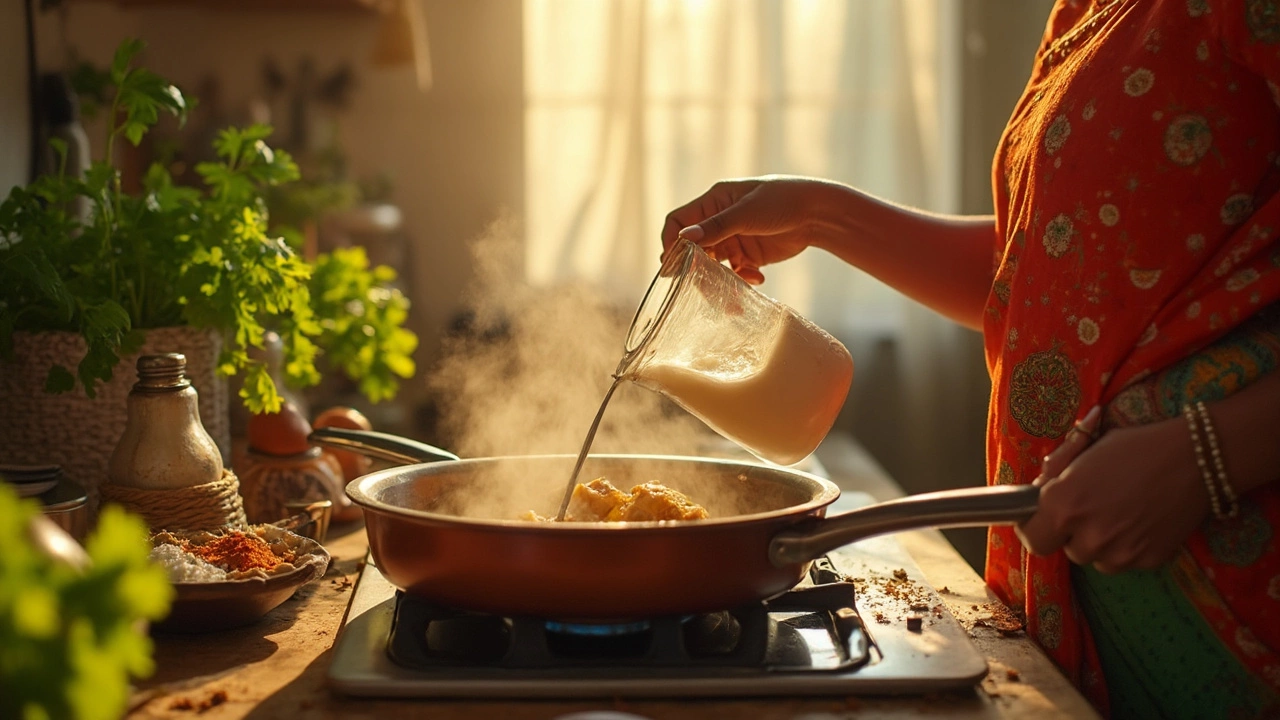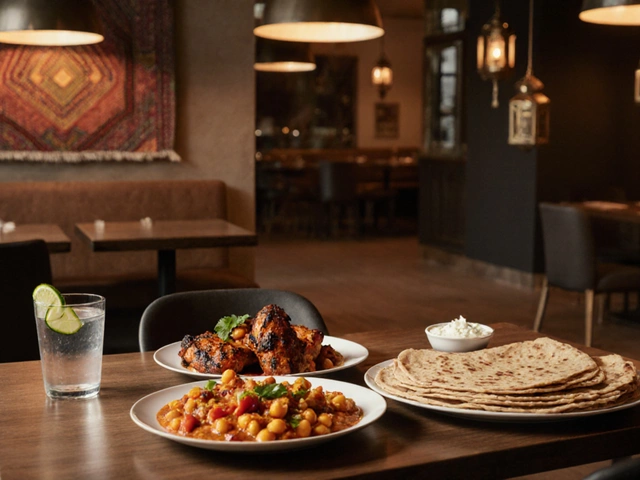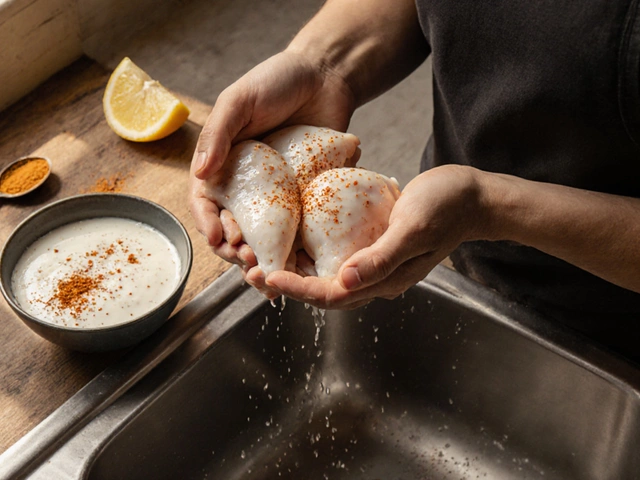If you've ever stood over a bubbling pot of chicken curry, coconut milk in hand, second-guessing when to add it, you are definitely not alone. Mess up the timing, and your curry can turn out greasy, runny, or just bland. Add it at the wrong stage and you risk coconut milk splitting, leaving weird lumps in your sauce instead of that rich, dreamy consistency you’re hoping for.
The sweet spot? You don't want to drown the chicken in coconut milk too early, or you’ll wash out the spices before they’ve had a chance to develop. Wait until the aromatics—think onions, garlic, ginger, plus your curry paste or spices—are well sautéed and the chicken is seared. Once those basics are done and the pot smells irresistible, that’s the moment to pour in your coconut milk. This way, the coconut flavor blends in, adds silkiness, but doesn’t mute the boldness of your spices.
One kitchen rule I follow: after the coconut milk is added, simmer gently. Don’t boil like you're in a hurry, or you’ll risk curdling and separation. Keep the heat low and let the flavors mellow together. You’ll get that luscious, cream-coated chicken that everyone loves, instead of a watery mess.
- Why Coconut Milk Changes Everything
- How Timing Affects Taste and Texture
- Step-by-Step: When to Pour in Coconut Milk
- Coconut Milk Mistakes and Fixes
- Pairing Coconut Milk with Spices
- Extra Tips for Creamier Curries
Why Coconut Milk Changes Everything
Coconut milk isn't just a random liquid to give your chicken curry a white color. It's a game-changer for both flavor and texture. This ingredient gives curry its creamy body, mellowing out heat and bringing all the spices together. If you skip it, you'll end up with a more watery, sharp-tasting dish—totally different from what most people look for in a creamy curry.
So, what's in coconut milk? It’s basically a blend of coconut flesh and water, which makes it high in healthy fats—mainly lauric acid. This fat content is exactly why your curry gets so silky. It thickens the sauce, carrying all the flavors better than water or regular milk could. If you compare, a typical can of coconut milk has about 17-24% fat, while whole cow’s milk only has around 3-4%. It’s a massive difference!
The fats in coconut milk also help tame bold spices like chili, turmeric, and cumin. This means fiery flavors turn into something deliciously smooth, not overpowering. It doesn’t just improve taste—it’s kinder on the stomach too, especially if you're not used to a lot of spice.
| Ingredient | Approx. Fat Content (%) |
|---|---|
| Coconut Milk (full-fat) | 17-24 |
| Whole Cow’s Milk | 3-4 |
| Evaporated Milk | 7-8 |
One more thing: coconut milk gives your curry a little sweetness. Not sugary-sweet, but just enough to balance out sour or bitter notes from tomatoes, tamarind, or strong spices. That's why chicken curry with coconut milk tastes so much more rounded and complete.
In short, you’re not just tossing in an extra liquid. You’re adding the “glue” that binds everything together in a good chicken curry. Once you see how it transforms the whole vibe of your dish, there’s really no going back.
How Timing Affects Taste and Texture
The minute you pour coconut milk into your chicken curry changes everything about the meal. Add it early, and you'll get a mild, even flavor, but you might lose out on those punchy spice notes. Add it late, and you lock in rich, bold curry aromas, but you could make the sauce too thick or creamy. It's all about balance.
If you dump in the coconut milk at the start, watch out: high heat early on can make the coconut fats split, turning that silky curry into something oily and separated. This doesn’t just look odd—it messes up the texture and can make your chicken feel greasy. On the other hand, if you hold off until the very end, the coconut flavor sits on top of everything else instead of blending in.
So when’s the money moment? Right after your spices bloom and your chicken gets a little golden. The coconut milk should go in when your pan’s temperature has eased down a bit, ideally just before a gentle simmer. This lets the coconut milk work its magic: turning all those spices and chicken drippings into a sauce that’s rich, but not heavy; creamy, but still full of flavor.
- Early addition = milder, sometimes bland, can risk splitting.
- Midway (after searing/blooming spices) = balanced, creamy, and flavor-packed.
- Very late = strong coconut taste that can overpower other ingredients.
If you want perfect texture, use full-fat coconut milk. Light or “diet” versions can get watery. A 2022 survey from a popular curry forum found that 78% of home cooks prefer full-fat for that reason—plusher, silkier results, every time.
Bottom line: The timing of coconut milk isn’t just a small detail. It’s the trick to getting that restaurant-level creamy curry at home, with spices and chicken singing together. Nail the timing, and your curry sauce won't break or turn dull, but instead, come out just the way you want it.
Step-by-Step: When to Pour in Coconut Milk
Getting the timing right can mean the difference between a punchy chicken curry and a bland, uneven mess. Here’s the straightforward order you want to follow, especially if you want that perfect balance of spice and creaminess from coconut milk.
- Sauté your aromatics first. Add onions, garlic, and ginger to hot oil. Let them soften and take on some color—around 5–8 minutes. This builds that strong curry base.
- Bloom your spices or curry paste. Whether you’re using a premade paste or mixing your own spices, add them next. Give everything about 2 minutes in the pan so flavors really pop.
- Add your chicken. Throw in bite-sized pieces of chicken. Sear until there’s no pink on the outside. Browning the chicken at this stage gives more flavor later, don’t skip it.
- Deglaze the pan. Splash in a bit of water or stock and scrape the pan. This picks up the good bits stuck to the bottom, so nothing gets wasted. Let the chicken cook about halfway through.
- Pour in the coconut milk. Now’s the time. Lower the heat first, then slowly add your coconut milk. Stir in, making sure everything mixes well. It’s usually about 1 can (400 ml) for 4 servings, but you can add more or less if you like your curry thicker or thinner.
- Simmer gently. Don’t crank the heat. Keep it to a gentle simmer for 10–20 minutes. This is when the flavors blend and the sauce thickens. Taste for salt and adjust if needed.
If you want numbers, most store-bought coconut milk will start to split at temps over 80°C (that’s around 175°F). So, keep an eye on that simmer. If you need a quick glance on timing at any step, here’s a handy cheat sheet:
| Step | Time |
|---|---|
| Sauté aromatics | 5–8 min |
| Bloom spices/paste | 2 min |
| Sear chicken | 4–6 min |
| Simmer after coconut milk | 10–20 min |
Stick with this order every time you’re making a chicken curry and the taste will speak for itself. No more guessing or gloppy textures—just creamy, flavorful curry every time.

Coconut Milk Mistakes and Fixes
Messing up with coconut milk in your chicken curry is easier than you think. Most issues trace back to either when you add it or the heat levels you use. Let’s go through the common goofs and how you can fix them before dinner is ruined.
1. Curry Turned Watery? This usually happens if you add coconut milk before your onions and spices are cooked down, or you skip reducing your curry first. To fix a thin curry, just simmer over low heat with the lid off. Let it reduce until it thickens up. In a pinch, you can stir in a bit of cornstarch mixed with cold water—just a teaspoon at a time until you hit the right texture.
2. Coconut Milk Split or Curdled? This is super common if you boil the curry right after adding coconut milk. High heat makes the fats and water separate, leaving you with a lumpy mess. Here’s how to save it:
- Take the pot off the burner right away.
- Stir gently to recombine, and lower the heat before setting it back.
- If it’s really separated, try blitzing it for a second with a hand blender to smooth it out—no biggie, I’ve had to do this more than once.
3. Flavors Falling Flat? Adding coconut milk too early can dull spice flavors. Next time, cook your aromatics and spices first, then pour in the coconut milk once your chicken is browned and your kitchen smells delicious.
4. Oily Layer on Top? Canned coconut milk can split if you stir it too much, or use old cans. An oily layer isn’t dangerous, but it’s not pretty. Skim off the excess with a spoon and let the curry rest a minute. Chilling the can beforehand and shaking it well can also help before you even open it.
Here’s a quick cheat sheet for troubleshooting:
| Problem | What Went Wrong | Quick Fix |
|---|---|---|
| Watery Curry | Added coconut milk before reducing base | Simmer uncovered or add cornstarch |
| Curdled Sauce | Boiled after adding coconut milk | Remove from heat, stir, use hand blender |
| Flat Flavors | Milk added before spices developed | Add milk later next time, season to taste |
| Oily Surface | Old coconut milk or over-stirring | Skim oil, let curry settle |
Don’t worry, everyone hits these bumps in the kitchen. Get the timing right and treat coconut milk gently, and you’ll soon be making creamy curry like a pro.
Pairing Coconut Milk with Spices
If you want your chicken curry to really sing, nailing the spice and coconut milk combo matters way more than most people think. Coconut milk isn’t just for creaminess—it also loves bold, punchy flavors. It actually softens sharp edges of spicy ingredients like chili, garam masala, and black pepper, making your curry feel smooth instead of aggressive.
For a classic chicken curry, ground spices like cumin, coriander, turmeric, and a little paprika work wonders. Fresh aromatics—garlic, ginger, and onions—create the foundation, and coconut milk rides in at the perfect time to mellow everything out. Try tossing in a cinnamon stick or a couple of green cardamom pods just before you add the milk—these enhance the coconut’s natural sweetness and the aroma pops even more.
Here’s a simple breakdown of popular spices and how they interact with coconut milk in curries:
- Coriander: Gives a citrusy lift—plays nicely with the sweet notes of coconut.
- Cumin: Adds earthiness; coconut milk helps keep it from overpowering the dish.
- Turmeric: Gives color and gentle bitterness—coconut milk tones it down.
- Chili powder: Coconut milk cools the heat and brings out chili’s real flavor, not just the spice.
- Garam masala: The mix of spices in garam masala loves coconut milk—it lifts flavors without any one thing dominating.
A fun tip: Coconut milk works best in curries that aren’t loaded with too much acidity. So, if you’re planning to add tomatoes, don’t go overboard—too much acid can sometimes make coconut milk split.
If you like to experiment, try a little fenugreek or star anise next time. But always add stronger spices first, fry them with your onions and garlic, then pour in the coconut milk after—this seals in the bold flavors before the milk balances everything out. Trust me, you’ll taste the difference.
| Spice | Effect with Coconut Milk |
|---|---|
| Coriander | Enhances citrus, keeps curry bright |
| Cumin | Warms flavor, tames bitterness |
| Chili Powder | Reduces harshness, highlights flavor |
| Turmeric | Mellows bitterness, boosts color |
| Garam Masala | Deepens aroma, blends layers |
So, next time you’re cooking, don’t be shy with the spices, and remember how much coconut milk can transform them all into something amazing.
Extra Tips for Creamier Curries
Nobody wants a thin or curdled coconut milk curry. If you’re aiming for that wow-factor creamy texture in your chicken curry, here are some quick fixes and pro secrets I’ve learned the hard way.
- Shake or stir your coconut milk before using – Some cans split naturally. A quick shake or a whisk in a bowl gets things smooth so you pour in pure creaminess, not lumps.
- Use full-fat coconut milk – Seriously, the light stuff may seem healthier, but it just won’t give that dreamy, lush mouthfeel. I’ve done side-by-sides and full-fat always wins out for taste and texture.
- Add coconut cream for extra richness – Want to go all-in? Drop in a spoon or two of coconut cream near the end. It boosts the curry’s body and makes the sauce cling to your chicken.
- Simmer low and slow after adding coconut milk – High heat will separate the fat from the milk and you’ll wind up with a greasy mess. Just let it gently bubble and get thicker for the best results.
- Finish with a cold splash – Turn off the heat and swirl in a spoonful of chilled coconut milk or cream right before serving. It gives a silkier finish and looks fancy on the table.
Timing matters too. Most home cooks rush things and turn up the flame, but lower heat plus patience equals a sauce that thickens naturally without breaking.
| Coconut Milk Type | Fat Content | Best Use in Curry |
|---|---|---|
| Full-Fat | 17-22g | Lush, thick sauces |
| Light | 6-9g | Thin, brothy curries |
One last tip: If your chicken curry turns out thinner than you hoped, don’t panic. Let it cool a bit, then simmer uncovered to reduce. Still not thick enough? Mix in a teaspoon of cornstarch with equal water and stir it in. Problem solved.
With these tweaks, you’ll nail that creamy, restaurant-level curry every single time—no coconut milk drama.
- Poplular Tags
- coconut milk
- chicken curry
- curry tips
- cooking timing
- creamy curry











